Posted: August 7th, 2015 | No Comments »
This newspaper picture shows a Japanese-manned machine gun post close to Peiping (Peking) in early 1938. The city had fallen to the Imperial Japanese Army in July 1937, though resistance continued in the countryside around the city.

Posted: August 6th, 2015 | No Comments »
A quick, and rather shameless, plug for an article by me that appears in the new issue of The Diplomat – Lingering Ghosts – dealing with how the war’s end brought the end of colonialism, the arrival of communism, and the rise of political dynasties across the continent. Click here.
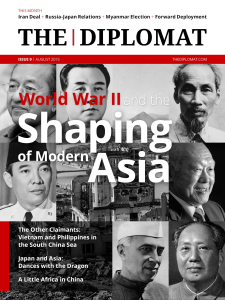
Posted: August 6th, 2015 | No Comments »
It’s unlikely any books of more use to anyone researching old Shanghai will be published anytime soon that surpass Doug Clarke’s three volume Gunboat Justice, now published by Earnshaw Books. Having read them I can honestly say they are very important and tell one of the most important stories of that period – extraterritoriality and the foreign courts system. All three volumes are now available as e-books on Amazon here.
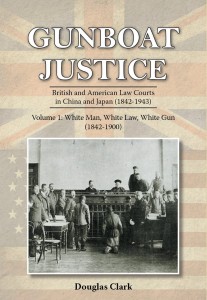
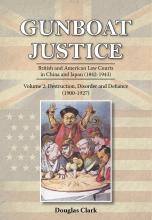
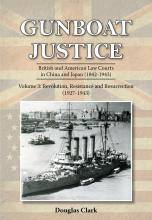
Posted: August 5th, 2015 | 1 Comment »
As journalists start to wonder about Zhangjiakou (where a chunk of the 2022 Winter Olympics will be held) they may want to know that in the old days the only place in town to get a drink and a room was the then legendary Pioneers’ Inn. The Pioneers’ Inn, the only European-style hotel in Kalgan, features in just about every memoir of every gunrunner, smuggler, ne’erdowell, spy and foreign adventurer ever to head into northern China. Every foreigner of a slightly suspicious bent pitched up at the Pioneers’ and ordered a chota peg (whisky and soda, the house drink). Others of interest also stopped there – Walter Granger, the great paleontologist stopped there in 1928 while the American reporter, spy, film maker, and translator Maguerite Harrison stopped there overnight in the early 1930s describing the rooms as “fairly clean”. Perhaps most famously the French cross-China expedition La Croisière Jaune, organised by Citroen, stopped there in 1932 for a while.
If anyone could track it down it would be the single thing about the Winter Olympics 2022 that would remotely interest me….
As to location that’s a bit tricky –
it was on the western edge of Kalgan
it was a brick built building
outside was rattan chairs and tables for a drink on a warm day
it was owned by some Swedes
It also had warehouses close by where people embarking on expeditions could store their gear
By 1935 it appears to have closed and been deserted
bon chance!
Posted: August 4th, 2015 | No Comments »
I’m a little out of my knowledge zone here but as Zhangjiakou (aka Kalgan as used to be known) is now to be hosting much of the 2022 Winter Olympics I guess this will all get resolved. This 1935 picture is described as the “Mongol Gate” in Kalgan – i.e. it led towards Inner Mongolia. I think this gate was sometimes referred to as the “North Gate”, as it was north of Peking (and so coming from Mongolia was the northern entrance to the greater Beijing area) and is now the Dajing Gate (with a few adornments that were not originally there on top and at the sides). The explorer Roy Chapman Andrews recalls having no end of trouble with the police trying to get through the gate back in the 1920s…hopefully the world’s bobsled and curling teams won’t have as much trouble in seven years time….
 Then….
Then….

Later – with a bit of build up around the sides and on top?
Posted: August 3rd, 2015 | 4 Comments »
I can’t remember how many times over the last couple of decades I’ve read that more highways will solve China’s connedctivity and logistics problems – highway mileage completed stats have long been an erroneous indicator. But it seems it’s nothing new – here’s reporting on new highways from 1935 concerning roads connecting Shanghai and Canton….

Posted: August 2nd, 2015 | No Comments »
Here’s an anecdote from 1924 about the day the American novelist Peter B Kyne (below – a now largely forgotten, but once very popular author, whose books were the basis for many silent movies), his wife Helen and their friend Carl Crow (resident of course in Shanghai) visited the battlefield at Lieuko. It seems to have been rather an exciting day…this tendency for foreigners to take a drive out to battlefields was a long established one with people visiting Taiping battles right through to watching the Chinese fight the Japanese after 1937. What on earth the combatants thought of these foreigners wandering through their battlefields is not recorded!!

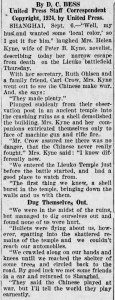

Posted: August 1st, 2015 | No Comments »
Franco David Macri’s Clash of Empires in South China looks at the effects on the wider fronts of the Japanese onslaught on the British Empire, especially Hong Kong, and the Soviet Union…

Japan’s invasion of China in 1937 saw most major campaigns north of the Yangtze River, where Chinese industry was concentrated. The southern theater proved a more difficult challenge for Japan because of its enormous size, diverse terrain, and poor infrastructure, but Generalissimo Chiang Kai-shek made a formidable stand that produced a veritable quagmire for a superior opponent–a stalemate much desired by the Allied nations. In the first book to cover this southern theater in detail, David Macri closely examines strategic decisions, campaigns, and operations and shows how they affected Allied grand strategy. Drawing on documents of U.S. and British officials, he reveals for the first time how the Sino-Japanese War served as a “proxy war” for the Allies: by keeping Japan’s military resources focused on southern China, they hoped to keep the enemy bogged down in a war of attrition that would prevent them from breaching British and Soviet territory. While the most immediate concern was preserving Siberia and its vast resources from invasion, Macri identifies Hong Kong as the keystone in that proxy war-vital in sustaining Chinese resistance against Japan as it provided the logistical interface between the outside world and battles in Hunan and Kwangtung provinces; a situation that emerged because of its vital rail connection to the city of Changsha. He describes the development of Anglo-Japanese low-intensity conflict at Hong Kong; he then explains the geopolitical significance of Hong Kong and southern China for the period following the German invasion of the Soviet Union. Opening a new window on this rarely studied theater, Macri underscores China’s symbolic importance for the Allies, depicting them as unequal partners who fought the Japanese for entirely different reasons-China for restoration of its national sovereignty, the Allies to keep the Japanese preoccupied. And by aiding China’s wartime efforts, the Allies further hoped to undermine Japanese propaganda designed to expel Western powers from its Greater East Asia Co-Prosperity Sphere. As Macri shows, Hong Kong was not just a sleepy British Colonial outpost on the fringes of the empire but an essential logistical component of the war, and to fully understand broader events Hong Kong must be viewed together with southern China as a single military zone. His account of that forgotten fight is a pioneering work that provides new insight into the origins of the Pacific War.











